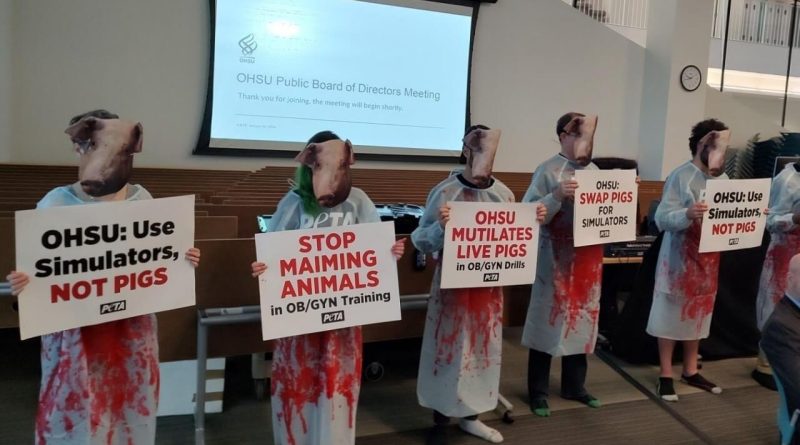Tell Oregon Health & Science University to Stop Using Live Pigs for Surgery Practice
Image from PETA
Our thanks to PETA for the information below and the opportunity to take action to stop it.
From PETA:
Doctors-in-training at Oregon Health & Science University (OHSU) use live pigs as human stand-ins to practice surgeries as part of the school’s obstetrics and gynecology (OB/GYN) residency program, according to disturbing public records obtained by PETA.
We sent a complaint to OHSU urging it to adopt a public policy against using live animals in its OB/GYN residency training, but officials have refused to respond. We need your help to demand that the school end this needless cruelty immediately.
The records PETA obtained show that at least 64 physician OB/GYN residents cut into as many as 48 live female pigs, dissected their organs, and performed other invasive surgeries on the animals—all of whom were later killed. Residents participated in five OB/GYN training drills on live pigs between 2019 and 2021 at OHSU, making the university an outlier among its peer accredited institutions and out of step with educational best practices.
Most Schools Have Moved On
Dozens of accredited OB/GYN residency training programs—including those at Texas A&M University, the University of California–Los Angeles, the University of North Carolina, and the University of Washington—have abandoned live-animal training, according to an ongoing PETA survey of the programs recognized by the Accreditation Council for Graduate Medical Education. Instead, programs such as the ones at Henry Ford Health, Rush University, and Aurora Sinai Medical Center use advanced, human-relevant simulators, which are equal, if not superior, to training on live animals. And the American College of Obstetricians and Gynecologists (ACOG) confirmed to PETA that “[p]rogramming offered by ACOG does not involve the use of live animals or animal parts.”
“The OB/GYN residency program at Henry Ford Hospital does not use animals for training purposes, and instead uses advanced human patient simulators and other non-animal methods.”
—Henry Ford Health, Obstetrics & Gynecology Residency
Even the U.S. Department of Defense has banned the use of animals for OB/GYN residency training and several other medical education areas since 2014, stating unequivocally that “suitable simulation alternatives can replace the use of live animals.” Furthermore, there are federal ethical provisions in place that compel the minimization of animal use in experiments and training, including the federal Animal Welfare Act.
Live-Animal Training Is Substandard Education
In medicine, lifesaving decisions must often be made within seconds, so familiarity with human anatomical structures is crucial. Pigs and other animals cannot accurately mimic human anatomy. They are simply not the same.
For instance, pig uteruses have an entirely different structure from human uteruses. Other key structures also have different lengths in pigs vs. humans. There are myriad microscopic anatomical differences between pigs and humans within each organ, too. Substandard training using pigs, such as OHSU’s, fails to prepare doctors for real-life situations.
Better Methods Are Available, Cheaper, and in Use
Non-animal human simulators are available, are in use, and have proved to be more cost-effective and efficient, while accurately modeling human anatomy and physiology. Human simulators, which range from high-fidelity human-patient simulation to computer-assisted learning, create immersive scenarios mimicking real-world medical cases, providing students with hands-on training immediately applicable to human patients.
Gynecological simulators ranging from partial task trainers to advanced virtual reality systems are available. For instance, researchers have validated a cost-effective non-animal simulation model to teach vaginal hysterectomy—and another study found that high-fidelity simulators were “cheaper than practicing on laboratory animals” in the long term.
What You Can Do
Please take a moment to visit PETA’s page on this issue by using the button below. It provides talking points and an opportunity to send a letter to multiple school officials plus a form that allows you to send a pre-written letter to still more.





